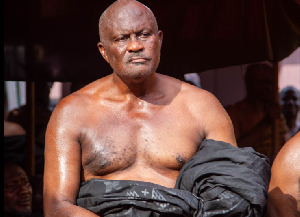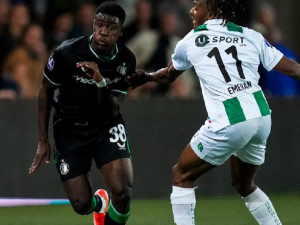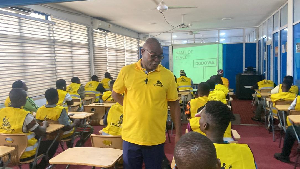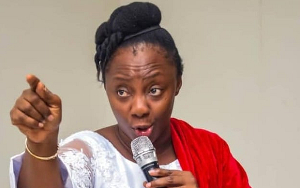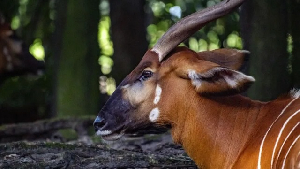(NB: This article contains a few Ewe words that have not been translated)
She was petite. She was cute. You could also say she was pretty. And she sang like an angel. Georgette Adjoavi Nafiatou Bellow was born on Monday, January 1st, 1945 in Tsévié, a village about 35 kilometres north of Lomé, the Togolese capital. As a kid, her nickname was “Toutouvi”. She was the eldest in a family of seven children. Her father was Togolese of Nigerian descent and her mother had her roots in Ghana.
After her primary school in Sokodé and secondary school in Agoe Nyive she proceeded to Abidjan to attend a secretarial school but took the opportunity to study music at the Institute of Arts (Ecole des Beaux-Arts d’Abidjan). Even though her teachers in her primary school had noticed her tremendous singing abilities, it was in Abidjan that her talents as a singer were first seriously recognized when she sang at a school function. At 21 she performed at the Festival of Black Arts (Festival Mondial des Arts Nègres, 1966) in Dakar – her biggest break so far.
After this breakthrough, Bella Bellow (which became her artist name) went to France where she was taken over by the Paris based Togolese producer Gérard Akueson in 1968. Akueson set out to market her as the next Miriam Makeba. But she had a different style from Makeba’s. In Paris, she worked on her own rhythms combining Togolese folklore with modern beats. This effort resulted in her first hit – Rockia (1969). This song lifted her to heights that she had never reached before especially in Africa. She went on a tour of mainly French speaking African countries - Cote d’Ivoire, Niger, Congo and the then Zaire, where she sang to adoring audiences. She then went on to represent Togo in a song festival in Tunis which gave her the chance to represent the entire continent at similar events in Athens and Rio de Janeiro.
Bella Bellow became one of the few Africans to perform at The Olympia in Paris – a big achievement in those days. Tours to other European countries then followed as she performed in Athens, Bonn and Belgium. Then she toured the West Indies playing in French colonies like Guadeloupe and Guyana. It was here that she was named “la blueswoman d’Afrique” (the blues woman of Africa). At the festival in Rio de Janeiro, she sang before 100,000 cheering spectators at the huge open-air Maracana Stadium.
Her success with European audiences was particularly due to the attempt by Akueson to present African music to the upmarket European audiences. The arrangements were snazzy with choruses sounding as if they were taken from Broadway. At the same time, there was something African in the beat which may have sounded exotic to European ears. Bem Bem, Sénye and Zelie are the best examples of this type of rhythm. Bellow was lucky to have worked with some very good musicians.
Bella Bellow broke with Gérard Akueson in 1971 and recorded some songs with Cameroonian born saxophonist, Manu Dibango. She then left Paris and came back home to set up her own group "Gabada", the name of a local Togolese place (and also a traditional Ewe dance). Blewu and Nye Dzi were recorded with this group.
Back in Togo her maternal instincts were stirring in her and she married the Togolese magistrate Théophile Jamier-Lévy in January 1972. The union produced her only child, Nadia Elsa.
Because her career was short, Bella Bellow has no more than 12 (or 13) recorded songs to her credit. In Ghana, her most popular number was Rockia. In the years around the 70s, every secondary school boy and girl in Ghana danced to this song. The opening drum roll got everybody scurrying off to find a place on the dance floor. There was no “records night” in secondary schools across Ghana in which this song did not feature. The itinerant dance bands that were common in Ghana in those days played versions of it at every performance. It was an often requested song on GBC 2’s popular “Listeners’ Choice” programmes. It was played in the beer parlours to the utter delight of the inebriate patrons. The song really deserved all the attention it got. It was Bella Bellow’s most danceable tune. It shook you even if you didn’t know what she was singing about. Everybody could sing along with “Abe alesi – Wo lolo ge”. And then there was that unforgettable bass guitar – don do non don don du duu, don do non don don du duu...
Rockia was released as the B side of a single (45 rpm vinyl). The A side that was not often played in Ghana is a song called Zelie. This was what GBC 2 played on its programme that featured only the flipsides of popular singles. Because of the popularity of Rockia, people forgot about Zelie which is actually a stunningly beautiful ballad in which Bella Bellow demonstrates the full range of her wonderful voice. A commentator says on its youtube entry that it is sung in the Kotokoli language of northern Togo and tells the story of the child bride who is leaving the maternal home to a marriage probably to a man whom she has never seen before and who may be several years older than she is. I don’t know if this is true. But I want it to be true so that I can easily imagine this little girl being virtually wrenched from her mother’s breasts and given away in marriage. Bellow’s haunting and plaintive voice is enough to draw the tears to your eyes. Just listen to the way she draws out the “Zeliiiii iyaa, Zeliii ayeee...”
Every song that Bella Bellow recorded is a gem. She sang in several languages but mostly in Ewe. Many of the tracks are short as was the practice in those days. There is the easy listening Blewuu (Patience or Gradually) written and composed by her in negro spiritual style, Sénye (My Destiny) with lyrics by Domenyo Agbétiafa, Lafoulou (described as having a “bossa nova rhythm”), Da Du Kodzo (her beautiful rendition of an old Ewe folksong), the romantic Nye Dzi (My Heart) that is said to be so beloved by males: (Nye magble wo / Di akpo o / ... Negbe ku ko / Ama mia me). Then there are the danceable tunes Awoula, Bouyele and even Bem Bem (with orchestration by the French musician Christian Joudinaud). The beautiful “Dasi Ko” is arranged by Manu Dibangu who also provided the orchestration. Listen to the wonderful final seconds of this tune when the chorus follows the bass guitar and repeatedly intones: “Da-si le nunye ko, Da-si le nunye ko, Da-si le nunye ko...” and Bellow’s raised voice as the song fades out on: “Novi novi novi novi... “.
But my personal favourite is Denyigba which may be her most commonly heard tune today. The arrangements to this track were made by Vladimir Kovaroc, renowned chief of the Bulgarian orchestra. The song is an ode to her motherland (Togo) but really a dedication to everybody’s homeland. We in Ghana compare this tune with our unofficial national anthem, more popular in Akan as “Yen Ara Y’asaase ni” but originally composed in Ewe by Ephraim Amu who initially called it “Amewo dzife nyigba”. This title is echoed in Bella Bellow’s song. Both songs talk about the homeland but the tunes are very different. Bella Bellow may have based her lyrics on the older Amu text but with significant differences. For instance, whereas the Amu text reminds us of the blood shed by “only” our forefathers to free this land for us, Bella Bellow specifically mentions our “forefathers” and “foremothers”: Miatogbui kple mamawo wo woto sinu / Vli denyigba la da di na nye kpli wo sia… The Amu text dares us to beware of what our fatherland will become: Denyigba wo nyonyo, denyigba wo gbegble /Alesi nele ko sigbe ko woano daa. But Bella Bellow expresses her everlasting love for her motherland (Dzinyefe o dzinyefe / Malo wo tegbee) saying she will never forget her no matter how bad she turns out to be: Alekeke alesike ye nano nam ‘la / Nye manlowo be ‘kpo gbede o... Both songs emphasize the essence in what the Ewes call “afe” (home as your place of physical and spiritual birth) with Bella giving the greater emphasis when she sings of “Dzinyefe ... Tefe afisi wo dzim do la”.
Bella Bellow has influenced a whole range of female Togolese singers. These include Vicky Bila, Afia Mala, Vanessa Worou. Angélique Kidjo is, perhaps, the most successful international artist who unabashedly mentions Bella Bellow as her greatest inspiration. Born in 1961, Kidjo may have been a little girl in her native Dahomey when the then president, Hubert Maga, invited Bella Bellow to perform on the occasion of the country’s fifth independence anniversary in 1965. Kidjo grew up listening to the music of Bella Bellow. Her first composition is said to be dedicated to her. She honours her again by performing versions of some Bellow songs: Sénye (sung without instruments), Blewu and Zelie (with minimal instrumental accompaniment). Kidjo is a great singer and these are very wonderful renditions. But it seems that what Bella Bellow touches, nobody can do it better. Far away from the West African coast, the very popular Congolese singer, Mbilia Bel (Boya yee, Nadina) has her own version of Rockia. (Do not listen to her words – they are neither Lingala nor Ewe!)
Bella Bellow played to packed houses in many French African capitals and in Europe singing her Ewe songs to adoring crowds but I am not aware of her ever playing any concert in Ghana. This is not surprising. Having been shaped in France, it was unlikely that her managers would easily get her into any English speaking African country – not even one that shares a border with her own country and in which many understood the language in which she sang. That is what colonialism has done to us. She did not attend Soul To Soul, the mammoth 16-hour international musical night (featuring many US based black singers) held at the Black Star Square to mark our independence anniversary in 1971. Ghana would have been her natural opening into the English speaking world. After all, there were many Ewes who were familiar with her music and she rocked all Ghanaians with Rockiaaaa. I will here stick out my neck and bluntly state that even though Ghana has produced some very fine female singers over the years (Charlotte Daddah, Christie Azumah), not a single one of them attained the same international status as Bella Bellow did!
In 1973, Manu Dibango started planning a tour of the USA with Bella Bellow to introduce the blues woman of Africa to the land of the blues. But that trip was destined never to be. On December 10, 1973, as Bella Bellow was being driven in a Ford Capri from her village, Lilikope, back to Lomé, the vehicle skidded off the road and somersaulted. Bella Bellow was violently tossed out of the car. Her head hit the asphalt. She suffered a brain hemorrhage and was killed instantly. She was only a few days short of her 28th birthday! Her daughter was only a few months old.
Rumours circulated about the “real cause” of her death. These implicated Gérard Akueson, her former producer and former lover, who, bad tongues said, was jealous and didn’t want the US tour to take place. There was also talk of a rival love affair and a jealousy that led to a paid domestic staff sabotaging her car. Others said it was envy of her success by people who used “African electronics” to do her in. Even in Ghana we heard the absurd rumour that the then president, Eyadema, wanted a liaison amoureuse with her which the good lady declined whereupon the leader arranged to have her killed. Up till today, nobody knows the exact cause of that vehicular accident. For all the rumours, the accident was probably one that happened naturally due to Togo’s bad roads and even worse driving habits. Or it may just have been something that Sé (Destiny) had ordained.
The Togolese have never forgotten their favourite daughter. December 1998 marked the 25th anniversary of the death of the diva and several activities were organised in Lomé and around the country in her memory. These included conferences discussing her contribution to Togolese culture, radio and television programmes and concerts. A few Bella Bellow look-alikes could be seen around town. Gérard Akueson produced a CD of her hits that sold at 10,000 francs – a huge sum for the ordinary Togolese but these CDs were snapped up like the proverbial hot cakes. The Togolese Postal Services issued a collection of stamps in several denominations bearing an image of her as the quintessential African woman in traditional headgear. Today, her grave site is a tourist attraction and a shrine to her dedicated fans some of whom were not born when she lived.
This year will mark the 40th anniversary of the death of this singing star. Who knows what further heights she would have reached if she had lived longer? For many of her blighted countrymen and women, Bella Bellow will forever remain the queen of the “Chanson modernes togolaise”.
NB: All the songs mentioned in this article can be heard on youtube and other music streaming websites.
Kofi Amenyo (kofi.amenyo@yahoo.com)
Opinions of Sunday, 21 July 2013
Columnist: Amenyo, Kofi






